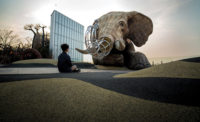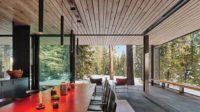With a mane of gray curls and an inveterate swagger, Charles Smith comes off as a middle-aged rock star rather than a winemaker. “He looks like Sammy Hagar,” says Tom Kundig, comparing his client to the former singer for Van Halen. But the onetime band manager has parlayed his unlikely affect—and talent for marketing it—into an international business selling award-winning but affordable wine with a punk aesthetic. He acts as chief spokesperson for his “Kung Fu Girl” Riesling and “Velvet Devil” Merlot, among several varietals. Smith brands them all with black-and-white labels that look like photocopied rock-show fliers, more suited to the sides of telephone poles than wine bottles.
In the decade since he opened his winery, Smith, 51, has emerged as a leading producer and an unrelenting provocateur in the valley that surrounds Walla Walla, Washington. The region has become increasingly known for its vineyards and has begun to draw wine tourists to its hilly landscape in the southeast corner of the state. As his profile rose, Smith started looking for a storefront where visitors could stop in to sample his handiwork and where he could host events. He also wanted to upgrade his office. “I needed a workspace for my team and a cellar door for the public,” says Smith. After seeing photos of Olson Kundig Architects' Chicken Point Cabin in Idaho, he approached the Seattle firm to convert a 5,000-square-foot auto-electric garage, dating from the 1920s, in downtown Walla Walla into a “world headquarters” for Charles Smith Wines. “He needed a stage,” says Kundig. “For the wine, but also for himself.” Despite the project's modest scale, with some creative design decisions and many moving parts, the space embodies the brashness of the brand and the impresario who leads it.
The designers left two of the garage's three bays mostly open, only partitioning off a rear loading dock with a sliding-steel panel and adding a lofted storage area above new restrooms and a small kitchen. They appointed the remaining space with easily reconfigurable furniture, including tasting counters and a set of steel-and-wood “rafts” that do double duty as seating areas and a stage. The movable elements allow the space to function as a tasting room during the day and accommodate any number of events in the evening; since its opening in 2011, Smith has hosted everything from burlesque shows to wedding receptions in the space.
Kundig left much of the interior's wear and tear as he found it—you won't find pictures of pastoral vineyards or stately chateaus. The brick walls still bear the occasional scribble of writing, and traces of white parking lines cross the concrete floors. Water stains from a roof that leaked for decades have left the wooden ceiling truss beautifully mottled. “It's a reference to the time it takes to make wine,” says Kundig of preserving the building's patina.
The only major intervention is the “armadillo,” a shoeboxlike volume with a prefab timber frame inserted into one-third of the garage. It encloses a conference room and an open-plan workspace for up to 10 employees of Smith's enterprise. “It's parked like a Trojan horse in one of the bays of the building,” says Kundig. The box gets its nickname from the 15 steel panels that cover its top and sides. The L-shaped plates slide on a set of tracks running along the floor of the box's long sides, and another running overheard through the center of the office ceiling. They open the workspace to the tasting room, blurring the line between front- and back-of-house. “The public sees what we do, and we see the public checking us out,” says Smith. The box is raised on a platform to accommodate electrical and data systems and lined with cork panels to provide some acoustical isolation—though with four 90-pound subwoofers mounted in the rafters, the default volume for the music in Smith's tasting room is loud.
The design team converted one of the garage's three street-side openings into an entry for the office. The other two hold glass garage doors with steel frames and sashes that open and close with one of Kundig's signature hand-cranked mechanical systems. When open, the doors cant dramatically over a fenced-in plot of sidewalk, which allows for sipping outdoors in warm months. It also brings the scene inside the space into Walla Walla's downtown. The storefront is on a side street, just across a creek from Main Street's commercial stretch, and Smith was determined to be noticed by pedestrians. He even suggested painting the entire exterior black, but Kundig talked him down. “He wanted people on Main Street to say, 'Woah, what's going on down there?' ” says the architect.
On a recent visit, the garage doors did the trick as a group of people walking by turned to watch Smith—clearly loving the physicality of the process—crank open part of the facade. The playful mechanism added tens of thousands of dollars to the cost of the job, but Smith says it was worth it for the attention that he gets. The project's combination of tough materials, street presence, and versatility has created a destination that holds its own with the personality of its owner. “Many of our clients have an urge to take risks,” says Kundig. “But Charles is a force of nature.”
Completion Date: April 2011
Gross square footage: 5,000
PeopleArchitect: Owner: KVintners and Charles Smith Wines Tom Kundig, FAIA, design principal; Les Eerkes, AIA, Principal, Project Manager; Chris Gerrick, LEED AP®, Project Architect Architect of record: Olson Kundig Architects Interior designer: Olson Kundig Architects and Client Engineer(s): KL&A, Spearhead and Maury Fortney Consultant(s): General contractor: Schuchart/Dow Inc. (general contractor) and Spearhead (prefabricated components) Photographer: Benjamin Benschneider (206-919-2030) CAD system, project management, or other software used: Revit |
ProductsStructural system Manufacturer of any structural components unique to this project: Spearhead produced the armadillo (timber frame, sliding steel panels, office cubicles/workstations, meeting table and accounting office) DoorsEntrances: Kawneer Demountable partitions: Spearhead Office furniture: Spearhead Add any additional building components or special equipment that made a significant contribution to this project: |





















